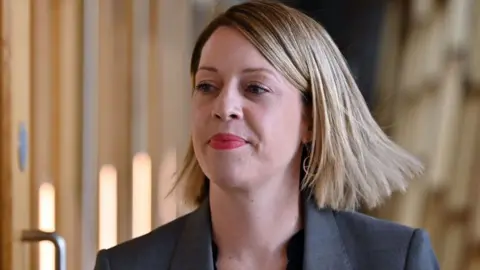Will new school rules help cut violence in the classroom?
 Getty Images
Getty ImagesThe best time to teach a child not to throw a chair in a classroom is not as it is being projected across the room.
That's what an educational psychologist told me last week as we discussed how teachers should respond to disruptive behaviour in schools.
Most people in education agree building positive relationships is the key to preventing violence in schools but teachers say they also need to be able to use "consequences" as well.
In the past few months I've spoken to dozens of teachers who say the balance between "nurture" and consequences has been lost.
And no-one wants to have a chair thrown at them.
In response to concerns from teachers, the Scottish government has now published guidance for schools on how to deal with violent and aggressive behaviour from pupils.
However, the Conservatives dismissed it as "waffle", saying it gives no clear instructions on when and how to exclude violent or disruptive pupils.
What's the problem?

Karen Simpson taught in a primary school in Inverness for 14 years but in 2018 she quit to become a tutor.
She said she loved the job but there was a "gradual" erosion of a teacher's ability to use boundaries that made it impossible to maintain discipline.
Her story chimes with the stories of so many others.
Teachers leaving the profession because the classroom behaviour has become too difficult, too overwhelming.
Parents too have told me their children are too nervous to go to school.
They say their kids are traumatised by the disruptive behaviour of other pupils who have repeatedly got away with swearing or violence and faced no boundaries.
Some call for a return to the days of corporal punishment in schools, when unruly children were disciplined by "the tawse".
It was outlawed in the 1980s in Scotland, for very good reasons, but some think the pendulum has swung too far with many councils focusing on the principles of "nurture".
What does the new guidance say?
For low-level disruptive behaviour the guidance suggests a range of measures.
These include offering children "an alternative activity to the rest of the class that allows the child to regulate their emotions or behaviour" or asking the pupil to "take a break for a short time".
The guidance also suggests access to learning support for pupils struggling to regulate their behaviour.
But teachers have told me there is already not enough learning support in schools.
For different levels of difficult behaviour the appendix to the guidelines suggests different staged interventions.
For children who are being violent one consequence is to give them a laminated piece of paper with bullet points reminding them how to behave and step away.
Other inventions include keeping the child in school but taking them to a different area to allow them to calm down.
What about exclusions from school?
For years there has been a presumption against removing kids from school.
Academics at Edinburgh University found that being expelled from school massively impacts young people's life chances in all the worst ways.
Glasgow dramatically cut its exclusions as did many other local authorities.
But in recent times teachers have been expressing growing concerns about some local authorities and schools misinterpreting the nurture principles by removing all or any consequences.
In her foreword to the guidance, Education Secretary Jenny Gilruth said exclusion should only be used as a "last resort".
The guidance says exclusion can be used in response to violence or anti-social behaviour, saying this measure can "allow matters to calm, time for planning, meeting with parents etc".
What was the reaction to the guidelines?
Teachers' unions have broadly welcomed the new guidelines but the EIS said they won't solve the behavioural problems in schools without significantly more resources and staff to support kids.
Education Secretary Jenny Gilruth said they will empower teachers in the face of rising levels of disruption and emotional dysregulation.
However, Tory education spokesman Miles Briggs said they were a pathetic response to the epidemic of violence in Scottish classrooms.
He said: "Teachers are still being given no clear rules on when and how they can exclude violent or disruptive pupils.
"Jenny Gilruth only mentions it as a last resort. Instead teachers are being fed waffle about eye-contact, hand signals and merits.
"These are utterly insufficient for dealing with the extreme behaviour that we've seen recently in classrooms up and down the country.
"Rather than clear rules, this document is full of Holyrood blob buzzwords about multi-agency processes, positivity and inclusion."
